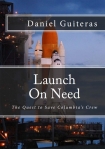Launch on Need, Daniel Guiteras [the giving tree read aloud TXT] 📗

- Author: Daniel Guiteras
Book online «Launch on Need, Daniel Guiteras [the giving tree read aloud TXT] 📗». Author Daniel Guiteras
Two months after the initial CAIB report was released, a technical support document entitled In-Flight Options Assessment (Volume II, Appendix D.13 of the CAIB report) was released, and it contained NASA’s answer to the Board’s hypothetical problem. The document contains several options for repairing Columbia’s wing while on orbit but, more importantly, it contains a stunningly detailed timeline for a rescue of Columbia’s crew.
Readers of the In-Flight Options Assessment document are strongly cautioned by the Board to remain cognizant that the rescue scenario in particular, while plausible, would have been extremely difficult to accomplish, that it leaves essentially no room for error, and that it makes assumptions that might not have succeeded in the real world.
You mean the astronauts could have been rescued?
It’s the first question that came to mind when I read the In-Flight Options Assessment, a question that immediately gripped my imagination and has never let go. The answer, according to NASA engineers, is that it might have been possible to save the crew. I won’t reveal how they planned to rescue the crew here, because the how serves as the backbone of this novel.
Throughout this fictionalized account of NASA’s rescue scenario, careful attention was paid to keeping references to the space shuttle’s technical specifications and capabilities accurate—the space shuttle is amazing enough on its own and needs no embellishment.
Any technical errors or omissions herein about NASA or the space shuttle are my own and are unintentional.
Out of respect to the Columbia astronauts and their families, references made to Columbia’s crew members in the story are made only through a generic use of astronaut designations such as commander or pilot, or by the substitution of fictitious names and characterizations.
Here’s to what might have been!
Daniel Guiteras
Part I
The Discovery
Chapter 1
Kennedy Space Center
Space Shuttle Integration Office
Columbia Flight Day 2
Friday, Jan. 17, 2003
9:47 AM EST
KEN BROWN PACED the narrow confines of his private office, his gait hobbled by chronic low back pain. He thought that if he walked a bit, coaxed a little oxygen through his aging frame, he’d catch a break. The truth? He was consumed by the haunting call of his pain pills. He’d let his once-rigid six-hour dosing schedule slip first to five hours, then four and, over the past few weeks, to just three hours. Now, still twenty minutes shy of the three-hour mark, he wrestled an unstoppable opponent. He paced faster, then suddenly broke stride, reaching desperately for his sport coat and the clear plastic bag that held his yellow tablets of hope. He quickly dry-swallowed two then fished through the left pocket of his tan khakis, working skillfully around a half-dozen Coffee Nips until he found four mint-flavored Tums.
His desk phone rang as he chewed the chalky bits of grit and worked to clear the white residue from his tongue. Caller ID showed it was Jeff Sims from NASA’s Marshall Space Flight Center in Huntsville, Alabama—it was a call he needed to take. On the fourth ring he held his breath, braced himself—prepared for a spike of back pain—then reached out and snatched up the receiver, beating his voicemail by a millisecond.
“Brown.” He coughed once to clear his voice.
“Seen the hi-res films from one-oh-seven yet?”
Brown lowered himself carefully to his chair, hoping to keep the pain from leaking into his voice. “Ah… no, no I haven’t.” He winced with the turn of his chair, glanced at the clock above his office door. “I was promised films within the hour, though. Why, have you got yours already?”
“No, not hi-res yet. But my guys don’t even like the prelims from 208.”
“How so?”
“We’re not one-hundred percent certain what we’re looking at yet,” Sims said, rushing to qualify his remarks. He knew Brown would crucify him if he assumed anything about the orbiter’s safety after having viewed only the preliminary launch films. “Ken, we think something struck the leading edge of Columbia’s left wing.”
“What? I looked at the prelims myself. Didn’t see anything like that.”
Brown knew E208 was a high-resolution video camera fitted with a 400-inch lens that began filming Columbia seven seconds before liftoff at a rate of 48 frames per second. By T-plus-240 seconds, it had run through 1,000 feet of film.
“I need the telemetry, Jeff. Tell me the time, speed and altitude,” Brown fired back, temporarily distracted from his pain.
“Okay, but understand this is still preliminary. We show the strike at 81.9 seconds after launch. Velocity was 2,300 feet per second. Altitude was about 65,000 feet.”
“Wait. 81.9 seconds? Are you sure about the time?” Brown couldn’t remember a debris strike of any kind so late in a launch. The engineers understood that as time elapsed, the shuttle’s velocity grew, increasing the amount of damage a wayward piece of debris could inflict on the orbiter’s tender skin.
Mass times acceleration.
“Those are the numbers I have now, but I think they’ll hold up in further study,” Sims said with concern in his voice.
Brown and his team, known as the Intercenter Photo Working Group, were responsible for analyzing video and still images from each shuttle launch to determine whether there were any “safety-of-flight issues”—NASA’s term for anything that put either the crew or vehicle at risk.
“Okay, so what’s your hunch?”
“What, as to the source?” Sims knew how Brown’s brain worked. “Not from our prelims, no. They’re far too blurry to say what struck the wing. If I had





Comments (0)